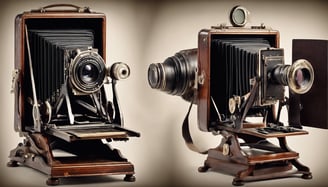The Evolution of Photography: From its Inception to the Present Day


The history of photography is a fascinating journey that spans centuries, from its humble beginnings to the sophisticated digital age we find ourselves in today. This art form has revolutionized the way we capture and preserve moments, allowing us to freeze time and create visual records of our world. Let's delve into the evolution of photography and explore how it has evolved over time.
The Birth of Photography
The story of photography begins in the early 19th century with the invention of the camera obscura, a device that projected images onto a surface. This laid the foundation for the development of the first true photograph. In 1826, Joseph Nicéphore Niépce captured the world's first permanent photograph, known as "View from the Window at Le Gras." This groundbreaking achievement paved the way for future advancements in the field.
The Daguerreotype and Early Innovations
In 1839, Louis Daguerre introduced the daguerreotype, a photographic process that produced highly detailed images on a silver-plated copper plate. This marked a significant milestone in the history of photography, as it made the medium more accessible to the public. The daguerreotype quickly gained popularity, and studios began to emerge, offering photographic services to the masses.
Throughout the 19th century, various advancements were made in photographic technology. The introduction of glass plates and the wet plate collodion process in the 1850s allowed for more efficient and higher-quality image capture. This period also saw the emergence of portable cameras, enabling photographers to venture beyond the confines of a studio and document the world around them.
The Birth of Film and the Age of Analog Photography
In the late 19th century, the invention of flexible film by George Eastman revolutionized photography once again. This breakthrough led to the creation of the Kodak camera, which was marketed as a simple and accessible device for capturing moments. The introduction of roll film made photography more convenient, eliminating the need for photographers to carry multiple glass plates.
The 20th century witnessed significant advancements in photography, with the introduction of 35mm film and the birth of the single-lens reflex (SLR) camera. These innovations allowed for greater control over exposure and composition, empowering photographers to push the boundaries of their art.
The Digital Revolution
The digital revolution in photography began in the 1980s and 1990s with the development of digital sensors and image processing technology. The advent of digital cameras marked a paradigm shift in the industry, as it eliminated the need for film and introduced instant image capture and manipulation.
Today, digital photography has become the norm, with smartphones equipped with high-quality cameras and professional-grade DSLRs offering unparalleled image quality. The rise of social media platforms and online photo-sharing websites has also democratized photography, allowing anyone with a smartphone or camera to share their work with the world.
The Future of Photography
As technology continues to advance, the future of photography holds exciting possibilities. From the emergence of mirrorless cameras to the integration of artificial intelligence and virtual reality, the boundaries of what is possible in photography are constantly being pushed.
Despite the ever-changing landscape, one thing remains constant: photography's ability to capture moments, evoke emotions, and tell stories. It is a powerful medium that has shaped our understanding of the world and continues to inspire and captivate audiences.
In conclusion, the evolution of photography has been a remarkable journey, from the early experiments with camera obscura to the digital age we live in today. As we look back at the milestones and innovations that have shaped this art form, we can only imagine what the future holds for photography.
